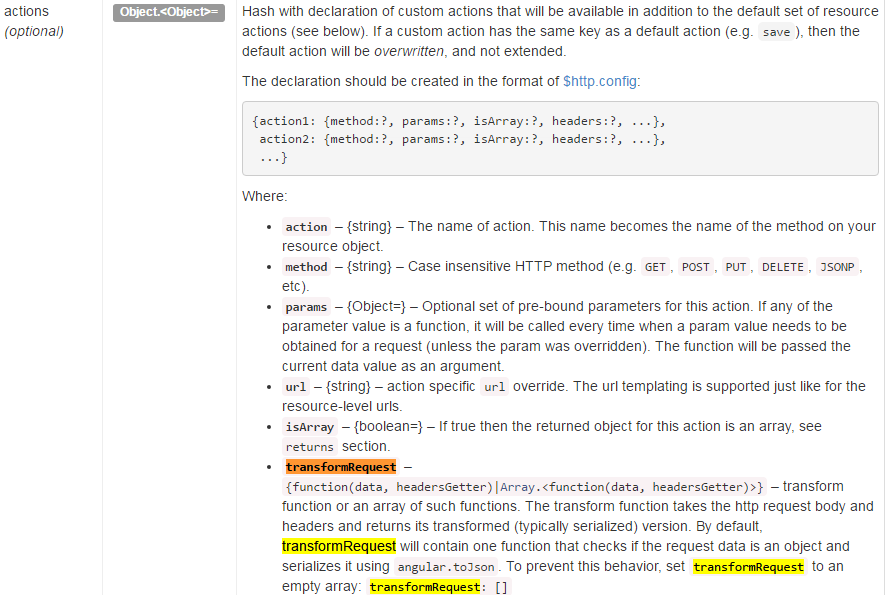最近着手开发一个后台系统,前端采用的是AngularJs来与后台交互,对于我们这群jquery疯狂的铁粉,遇到了不少转不过弯的问题,为了更高效的开发应用,在私下的时间收集和改造了一下AngularJS的$http 服务,特此分享。
$http的post
. 请求默认的content-Type=application/json
. 提交的是json对象的字符串化数据,
. 后端无法从post中获取,
. 跨域请求是复杂请求,会发送OPTIONS的验证请求,成功后才真正发起post请求
jQuery.post
. 使用的是content-Type=application/x-www-form-urlencoded -
. 提交的是form data,
. 后端可以从post中获取,
. 简单跨域请求,直接发送
解决思路:
1.改造前端
(1)方案一:
配置$http服务的默认content-Type=application/x-www-form-urlencoded,如果是指配置这个的话,虽然提交的content-Type改了,但是提交的数据依然是个json字符串,不是我们想要的form data形式的键值对,需要实现param方法.
angular.module('MyModule', [], function($httpProvider) {
// Use x-www-form-urlencoded Content-Type
$httpProvider.defaults.headers.post['Content-Type'] = 'application/x-www-form-urlencoded;charset=utf-8';
/**
* The workhorse; converts an object to x-www-form-urlencoded serialization.
* @param {Object} obj
* @return {String}
*/
var param = function(obj) {
var query = '',
name, value, fullSubName, subName, subValue, innerObj, i;
for (name in obj) {
value = obj[name];
if (value instanceof Array) {
for (i = 0; i < value.length; ++i) {
subValue = value[i];
fullSubName = name + '[' + i + ']';
innerObj = {};
innerObj[fullSubName] = subValue;
query += param(innerObj) + '&';
}
} else if (value instanceof Object) {
for (subName in value) {
subValue = value[subName];
fullSubName = name + '[' + subName + ']';
innerObj = {};
innerObj[fullSubName] = subValue;
query += param(innerObj) + '&';
}
} else if (value !== undefined && value !== null)
query += encodeURIComponent(name) + '=' + encodeURIComponent(value) + '&';
}
return query.length ? query.substr(0, query.length - 1) : query;
};
//一个function数组,负责将请求的body,也就是post data,转换成想要的形式
// Override $http service's default transformRequest
$httpProvider.defaults.transformRequest = [function(data) {
return angular.isObject(data) && String(data) !== '[object File]' ? param(data) : data;
}];
});
配合一点$resource的API参考,这个代码就好懂了:
https://docs.angularjs.org/api/ngResource/service/$resource

Note:
上述param方法定义的地方不要使用jQuery.param方法,因为jQuery.param方法会将要处理的对象上的function全执行一边,把返回的值当做参数的值,这是我们不期望的,我们写的这个param方法也是为了解决上面说的content-Type=x-www-form-urlencoded,但是提交的数据依然是json串的问题。
方案二:
$scope.formData = {};
$http({
method: 'POST',
url: '/user/',
data: $.param($scope.formData), // pass in data as strings
headers: { 'Content-Type': 'application/x-www-form-urlencoded' } // set the headers so angular passing info as form data (not request payload)
})
.success(function(data) {
console.log(data);
if (!data.success) {
// if not successful, bind errors to error variables
$scope.errorName = data.errors.name;
$scope.errorSuperhero = data.errors.superheroAlias;
} else {
// if successful, bind success message to message
$scope.message = data.message;
}
});
参考
http://victorblog.com/2012/12/20/make-angularjs-http-service-behave-like-jquery-ajax/
2.后端使用注意:
(1)Spring MVC ajax后台方法不能加 @RequestBody ,否则会报Failed to load resource: the server responded with a status of 415 (Unsupported Media Type)错误
(2)使用Jquery 风格的写法就OK啦!
万事搞定,只欠高效开发,O(∩_∩)O哈哈~















